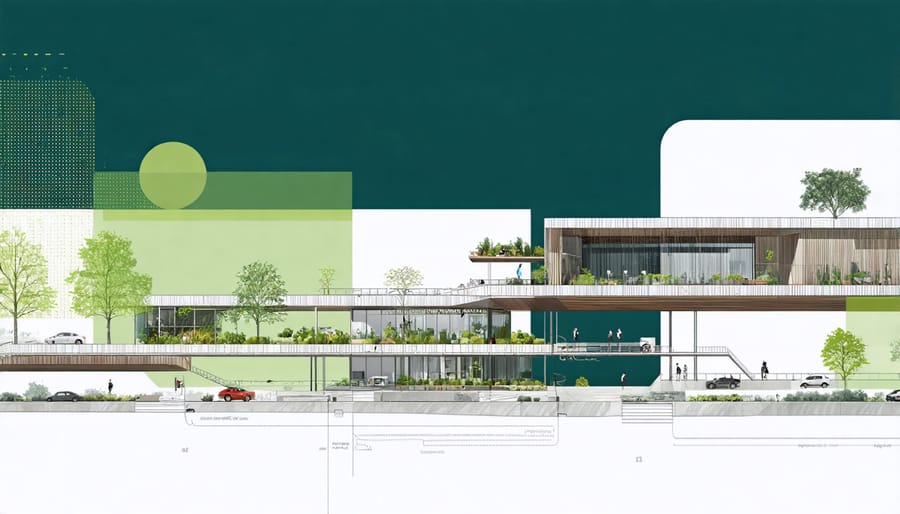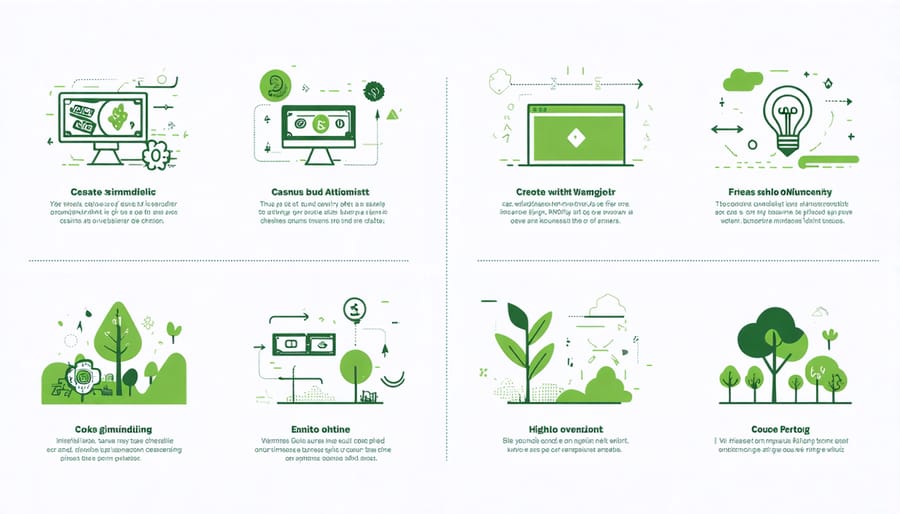Innovate your approach to sustainable gaming by starting with a switch to digital platforms, minimizing waste through the reduction of physical gaming materials. Explore the realm of bitcoin casinos to embrace digital currency and reduce your carbon footprint associated with traditional monetary transactions. Incorporate agritecture strategies by integrating green roofs and vertical gardens in game development studios or server farms, effectively reducing energy costs and promoting urban biodiversity. Collaborate with environmental experts and architects to design eco-friendly gaming venues or online environments that prioritize renewable energy sources, encouraging the gaming industry to set benchmarks for sustainability.
Understanding Green Gaming

What Is Green Gaming?
Green gaming refers to the application of sustainable practices within the gaming industry, particularly in online casinos, to reduce their environmental impact. As the digital world continues to expand, so does its carbon footprint, prompting innovative solutions from operators who are keen on aligning with eco-friendly values. The main objectives of green gaming include minimizing energy consumption, reducing waste, and integrating renewable energy sources. For instance, data centers hosting online casinos can adopt energy-efficient technologies and cooling systems, significantly cutting down on emissions. In practice, some casinos are partnering with green tech companies to ensure their servers run on renewable energy, while others are supporting reforestation projects to offset their carbon footprints. By embracing green gaming, the online casino industry not only addresses urgent environmental issues but also leads by example, encouraging players to adopt sustainable habits in their own lives. This vibrant convergence of technology and ecology resonates with the values of eco-conscious gamers and stakeholders alike.
Environmental Benefits of Green Gaming
As the world embraces greener practices, online casinos are joining the movement with green gaming initiatives, significantly reducing their carbon footprint. By shifting operations to energy-efficient servers, they decrease electricity consumption, which is crucial in an increasingly digital age. Many platforms now utilize renewable energy sources like solar and wind power to run their operations, helping to minimize environmental impact while maintaining optimal performance.
In addition to energy-efficient infrastructure, some online casinos are prioritizing digital-only solutions, reducing the need for physical space and resources associated with traditional casinos. This shift not only supports energy conservation but aligns with agritecture principles by freeing up urban spaces for green development projects, like urban farms and community gardens.
These efforts also extend to collaborative initiatives with eco-focused organizations to promote sustainable practices, inspiring players and other businesses. By actively pursuing greener operations and encouraging sustainable urban planning, the online gaming industry is exploring innovative pathways in its commitment to a more sustainable future.
Agritecture: Blending Agriculture and Architecture
Defining Agritecture
Agritecture blends agriculture with architecture to create spaces that are not only aesthetically pleasing but also functional and sustainable. This concept introduces the idea of growing food within urban environments, merging the built environment with nature. By integrating agritecture into urban landscapes, cities can enhance their food security efforts, improve air quality, and reduce their carbon footprint. Imagine skyscrapers adorned with vertical gardens or rooftops transformed into bountiful vegetable patches. These spaces provide significant urban gardening benefits while making cities greener and more livable.
Through the implementation of agritecture, urban dwellers can engage with their environment in innovative ways, combining traditional gardening techniques with modern technology. This approach not only promotes sustainability but also encourages community collaboration, bringing together a professional team of architects, city planners, and residents to work towards a greener future. Intertwining nature with urban design inspires a reevaluation of city living, showcasing how sustainable practices can seamlessly integrate into our daily lives.

Applications in the Gaming Sector
In the gaming sector, agritecture can revolutionize sustainability by integrating agricultural principles into virtual environments and operational practices. Online casinos and gaming platforms can adopt green practices by imagining new game worlds where sustainability is core to gameplay. This could include virtual farms or cities with goals centered around resource efficiency and ecological balance, educating players on sustainable habits while delivering an engaging experience.
Additionally, industry operations can embody agritecture by employing eco-friendly infrastructure for data centers, like using recycled materials and renewable energy sources. Just as with physical agritecture projects that incorporate water filtration in farming, similar systems can be mirrored in online gaming to reduce water usage and emphasize conservation.
Collaboration with developers and architects can help create digital spaces that reflect real-world sustainability goals. By doing so, the gaming industry not only entertains but also inspires a global community of gamers to consider and adopt greener lifestyles, creating a virtual and real-world impact towards sustainability.
The Intersection of Green Gaming and Agritecture

Innovative Strategies for Online Casinos
In an era where sustainability is no longer optional, online casinos have a unique opportunity to embrace innovative strategies by integrating green gaming with agritecture practices. Green gaming, at its core, involves promoting sustainable practices within the gaming industry, such as reducing carbon footprints and encouraging eco-friendly choices among players. By weaving in agritecture—an architectural approach that incorporates agricultural elements into urban environments—online casinos can revolutionize their operations and offerings.
Imagine an online casino platform that uses servers powered by renewable energy sources, significantly cutting down on emissions. These platforms could partner with agritecture professionals to design virtual gaming experiences inspired by verdant, sustainable landscapes, motivating players to consider eco-friendly lifestyles. The virtual spaces could feature real-world agricultural practices that naturally integrate with the casino’s themes, showing the harmonious blend of gaming entertainment and ecological responsibility.
Moreover, encouraging collaboration between agritecture experts and online gaming developers can lead to innovative, green-focused game themes that not only entertain but also educate. For example, players could participate in virtual farming or sustainable city-building games that reflect real-world agritecture principles. Embracing these strategies not only highlights an eco-conscious brand identity but also attracts urban dwellers and eco-conscious individuals interested in sustainable living. As the industry evolves, these innovative approaches can spark a transformative shift in how online casinos can contribute to a greener future.
Case Studies and Examples
In the heart of urban sustainability, the convergence of green gaming and agritecture is taking root, yielding innovative projects that inspire change. One standout example is the development of an indoor vertical farm in a former theater space. This project not only redefines how urban areas utilize space but also integrates technology to foster sustainable urban agriculture. By incorporating gaming elements into the farming process, this initiative transforms what might seem like a niche approach into an engaging experience for city dwellers and planners alike. These indoor farming innovations demonstrate the harmony between technology and nature, emphasizing sustainability in dense urban settings.
In a similar vein, a pioneering gaming company has partnered with eco-friendly architects to create virtual gaming environments that mimic sustainable cityscapes. These digital realms are designed to educate players about real-world environmental issues and promote sustainable choices. This fusion of gaming and agritecture not only propels the gaming industry towards eco-consciousness but may also influence urban architectural design by showcasing visionary examples of green living. Together, these case studies showcase the transformative potential of merging gaming with agritecture, equipping urban populations and professionals with a blueprint for a greener, more sustainable future.
Challenges and Opportunities
Overcoming Practical Challenges
Implementing green gaming and agritecture faces several challenges, but with strategic planning, they can be overcome. One key barrier is the initial cost, as integrating sustainable practices into existing systems can be expensive. However, forming collaborative teams of professionals across the gaming and architecture industries can spread costs and expertise. Not only does this approach encourage innovative solutions, but it also drives efficiencies and shared resources. Urban dwellers and planners might encounter space limitations—an inherent hurdle in densely populated areas. To tackle this, vertical gardens and rooftop farms can maximize available area, making the most of city landscapes. Another challenge is the mindset shift required for both industry insiders and consumers. Education and awareness campaigns are crucial, highlighting the environmental and financial benefits of sustainability. Engaging eco-conscious families and urban dwellers in ‘green gaming’ challenges can gamify the learning process, making it more accessible and engaging. Through resilience and collaboration, we’re one step closer to integrating nature into urban gaming environments.
Future Opportunities for Growth
As we look towards the horizon of green gaming and agritecture, the future glimmers with promising opportunities for integrating sustainability within the gambling and online casino industry. Imagine sprawling urban locales where gaming hubs are housed in agritectural marvels, combining energy efficiency with vertical gardens that cleanse the air and boost player well-being. This isn’t just a futuristic vision—it’s achievable with strategic collaboration among architects, city planners, and gaming professionals. Embracing renewable energy can power online platforms, cutting emissions and operating costs, while providing players with an eco-friendly gaming experience. Moreover, incorporating smart technology can optimize resource management, ensuring minimal environmental impact. With a continuous commitment to research and innovation, the industry can create a new standard of environmentally conscious entertainment, inspiring others to reimagine the synergy between modern leisure activities and sustainable urban living. The path to a greener gaming future awaits, paving the way for a thriving, responsible lifestyle that aligns with the planet’s needs.
Conclusion
Integrating green gaming and agritecture into the online casino industry opens exciting possibilities for sustainable innovation. By creating virtual spaces inspired by eco-friendly architecture and practices, the industry can significantly reduce its carbon footprint while engaging a growing audience passionate about sustainability. This unique blend encourages environmentally conscious thinking, fostering community-driven initiatives, and reshaping user experiences in creative, planet-friendly ways. As we look forward, professional collaboration between eco-enthusiasts, urban planners, and gaming developers could lead to transformative changes. Let’s seize this opportunity to redefine entertainment and architecture with a green thumb, making sustainability not just a concept but a lifestyle.

